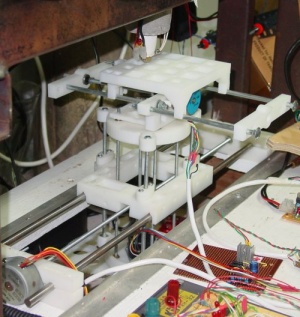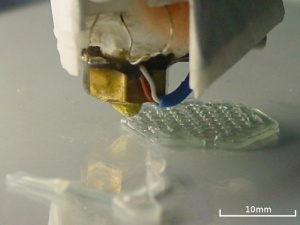|
Rapid prototyping machines are like three dimmensional printers that turn CAD designs into solid objects, by building up extremely thin cross-sectional layers one on top of the other. Currently they are used mostly in industry to create accurate parts for developmental designs and prototypes. But they are increasingly being used in short manufacturing runs and is known in this circumstance as rapid manufacturing. These techniques are known as solid freeform fabrication.
There are various types
>Intro
>Different types
>Materials
>Advantages
>Limitations
RepRap
 RepRap 0.1 prototype (created by Vik Olliver)  RepRap 0.1 building an object RepRap is rather special prototyper. The name is short for replicating rapid prototyper. It is a project started at the University of Bath, UK by Dr. Adrian Bowyer, a Senior Lecturer in mechanical engineering.
The idea is to create a rapid prototyping machine that, as well as being able to construct useful three dimmensional objects to order, is also able to create all the parts necessary to build another rapid prototyping machine. So for a very low cost, someone with a RepRap should be able to clone a new machine to give to someone else.
It uses the Fused Deposition Modelling (FDM) system of additive construction where a thermoplastic material is extruded very thinly from a computer controlled nozzle to slowly build up a three dimmensional shape layer by layer.
However there are various parts that it cannot currently reproduce such as the stepper motor, microcontroller, extrusion nozzle and lubricant. However over time as the design evolves and becomes more sophistacated it is envisioned that there will be less and less parts that cannot be made by the machine itself.
When I last saw Adrian he said he was planning on incorporating four extruder nozzles into the machine, each applying a different material. The first extrudes a thermoplastic that creates the structure of what is being made. The second extrudes wood's metal[1] which is a low melting point
Growing
This is an Open design project in that everything relating to it - i.e. the plans, the 3D CAD models of the components and the software to run it are being released under the GPL license[2] which enables anyone to use, customize and evolve it. The terms of the GPL also mean that any improvements should likewise be available under the GPL for other s to benefit from.
http://en.wikipedia.org/wiki/RepRap_Project
|